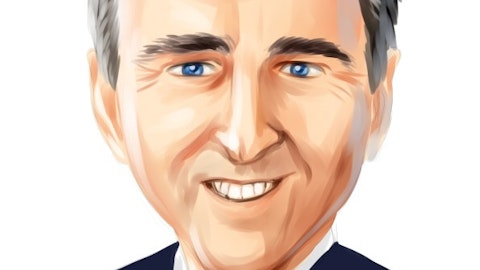West Pharmaceutical Services, Inc. (NYSE:WST) Q4 2023 Earnings Call Transcript February 15, 2024
West Pharmaceutical Services, Inc. beats earnings expectations. Reported EPS is $1.83, expectations were $1.78. West Pharmaceutical Services, Inc. isn’t one of the 30 most popular stocks among hedge funds at the end of the third quarter (see the details here).
Operator: Thank you for standing by, and welcome to West Pharmaceutical Services Fourth Quarter 2023 Earnings Conference Call. [Operator Instructions] I would now like to hand the call over to Vice President, Strategy and Investor Relations, Quintin Lai. Please go ahead.
Quintin Lai: Thank you, Latif. Good morning, and welcome to West’s Fourth Quarter and Full Year 2023 Conference Call. We issued our financial results this morning, and the release has been posted in the Investors section on the company’s website located at westpharma.com. This morning, we will review our financial results, provide an update on our business and present an update on our financial outlook for the full year 2024. There’s a slide presentation that accompanies today’s call, and a copy of the presentation is available on the Investors section of our website. On Slide 4 is our Safe Harbor statement. Statements made by management on this call and in the accompanying presentation contain forward-looking statements within the meaning of U.S. federal securities law.
These statements are based on our beliefs and assumptions current expectations, estimates and forecasts. The company’s future results are influenced by many factors beyond the control of the company. Actual results could differ materially from past results as well as those expressed or implied in any forward-looking statement made here. Please refer to today’s press release as well as any other disclosures made by the company regarding the risks to which it is subject including our 10-K, 10-Q and 8-K reports. During today’s call, management will make reference to non-GAAP financial measures, including organic sales growth, adjusted operating profit, adjusted operating profit margin and adjusted diluted EPS. Reconciliations and limitations of the non-GAAP financial measures to the most comparable financial results prepared in conformity to GAAP are provided in this morning’s earnings release.
I now turn the call over to our CEO, Eric Green.
Eric Green: Thank you, Quintin, and good morning, everyone. Thanks for joining us today. We’ll start on Slide 5. Last year, we celebrated West’s 100th anniversary of groundbreaking health care innovation, which is one of many proud highlights shown on this recap slide. I also want to thank our team members who are connected by our strong responsibility and shared values that continue to help us succeed each day. Now turning to Slide 6, where I’ll cover 3 main topics. First, we will examine the drivers of 2023. Second, we will discuss the challenges ahead in 2024. And third, we will talk about the drivers of growth that we’ll return West to long-term financial construct of sales and margin expansion in 2025. Let’s begin with our financial results.
I am pleased with the strong base growth in 2023, which more than offset a decline of COVID-19-related sales of approximately $320 million. Excluding pandemic-related sales, we had strong base overall organic sales growth in the mid-teens. Driving this base growth is the expanding customer demand for our high-value product offerings, both components and devices, and for our contract manufacturing services. During the year, we made great strides with our capital expansion plans across our global network. For example, in Kinston, we expanded our footprint with new NovaPure capacity, and we’re in the process of a significant expansion in our HVP processing capacity. At our Grand Rapids contract manufacturing site, we brought online new capacity for a customer’s injection device in late 2022, which contributed to growth in 2023.
We also have been able to successfully address our backlog of long lead times for certain products. This has been a challenge since the start of the pandemic, and thanks to the hard work of our teams through both optimization and capacity expansion, we have exited the year with normalized lead times. Moving to Slide 7. As we turn our attention to 2024, we are facing several challenges to our growth model as indicated in our preliminary outlook from October. With greater visibility of a changing market landscape, we expect 2% to 3% organic sales growth for the full year or about 5 to 6 percentage points lower than our preliminary outlook. This difference comes from 4 main factors. First, we had expected flat COVID-related sales this year, instead, demand continues to decline, which resulted in about 1% point decrease in organic sales.
Second, timing of HVP device manufacturing capacity coming online to satisfy customer demand has been pushed out, causing a percentage point of headwind. Third, timing of a customer’s upgrade to a higher HVP tier has caused a percentage point of headwind. And finally, fourth, a more widespread destocking is causing approximately 2 to 3 percentage points of headwind. Towards the end of the year and into January, the industry inventory management trend and other life science tools companies have been experiencing has now reached our segment of the injectable drug value chain. While we thought we might see some impact in 2024, we were surprised with the breadth, latitude and speed at which customers change their forecast. In several of these cases, customers express to us the same sentiment at the amount of forecast changes that were being handed to them.
As we look to overall quarterly pacing for 2024, we expect that Q1 will have the largest negative impact due to destocking as well as timing of new HVP device capacity and customer-led HVP upgrade. We expect in Q1 that proprietary products will be down by high single decline. We expect some effect, but to a lesser degree in Q2 with positive proprietary products and consolidated organic growth. And we expect the second half of the year to have better growth with Q4 in line with our long-term financial construct. As we set our 2024 guidance and quarterly cadence, we see several areas that support our expectations. First, our February order book for the second half of the year has a higher coverage ratio than prior pre-pandemic levels. Second, we have some customers that are expected to be able to produce more drugs as the year progresses.
Third, we expect HVP device capacity to improve in the second half of the year as we implement process modifications that were designed to improve manufacturing throughput. I am disappointed that we will not achieve our usual full year organic sales and margin expansion in 2024. As I’ve outlined, outside of further COVID demand reduction, some of the impact is time-related to new capacity and timing of customer upgrades. As for destocking, this is an industry-wide situation, not a change in market share or patient demand for drug volumes. Looking beyond 2024, we continue to be bullish on our growth construct and our teams will have another active year of capital investments in 2024. Moving to Slide 8. We will be expanding our industry-leading capacity with major HVP expansion projects in Jersey Shore and Eschweiler as well as other projects across the global network.
Another driver of growth with a bright future comes from our HVP devices, which includes our injection delivery device platforms, Crystal Zenith containment solutions in the admin systems. HVP devices had very strong double-digit organic sales growth in 2023 and now represent 10% of overall sales. Less platforms are an integral part of our customers’ drug device combination products that are making a difference to patients. And this year, we have had multiple capital expansion projects that will increase capacity for SmartDose, SelfDose and admin systems, with some expected to come online in the second half of 2024 and fully online in 2025. As mentioned at the outset, contract manufacturing had growth contribution from new capacity at our Grand Rapids site to support our customer’s injection device platform.

Looking ahead, we’re excited to have started a significant expansion at our Dublin facility, which is already dedicated to contracted demand for future injection device manufacturing. We expect to be completed and validated in 2024, which places us in a great position for 2025 growth. I also want to take some time to talk about the dynamics of future demand related to our growth drivers for HVP components. As you know, we have been building HVP capacity for several years and expect it to continue to do so in 2024. We see a robust runway of volume growth over the next few years. As a foundation, we expect volume growth of existing drugs with increasing ageing patient populations, expanding geographical reach and evolving treatment guidelines and market conditions.
In addition to overall volume growth, we continue to experience and see certain drugs have breakthrough growth. For example, we are experiencing a similar surge in demand for components associated with drugs treating diabetes and obesity. Our responsibility as the industry leader in primary packaging is to be prepared for incremental jumps in demand. And lastly, the area with the most potential for our future growth is our HVP capacity to support and mix shift. For mix shift, we see a combination of volume from new drugs that enter the market and from legacy drugs that upgrade from either a standard component or lower to a higher HVP category. The mix shift of legacy to HVP has historically been a smaller contributor for us compared to contribution from newly approved drugs.
However, with the industry landscape changing, regulators are introducing new regulations for higher quality, lower particulate, and more standardized solutions. And therefore, customers are looking to upgrade their standard primary components. When we look at that over the next few years, we estimate that several billions of our primary containment components in standard form could benefit from a mix shift to our modern formulation and HVP processes. We recognize this mix shift will take time, but we anticipate as new regulation changes are enforced. This adoption will accelerate. By considering our combination of growth drivers from volume, price and HVP mix shift, we can confidently assert that we will be well equipped to navigate the challenges and continue to fuel our long-range financial construct of 7% to 9% annual organic sales growth and at least 100 basis points of operating margin expansion per year.
Now I’ll turn the call over to Bernard. Bernard?
Bernard Birkett: Thank you, Eric, and good morning. Let’s review the numbers in more detail. We’ll first look at Q4 2023 revenues and profits, where we saw low single-digit organic sales growth and an increase in diluted EPS and operating profit. I will take you through the drivers impacting sales and margin in the quarter as well as some balance sheet takeaways. And finally, we will review our 2024 guidance. First up Q4. Our financial results are summarized on Slide 9 and the reconciliation of non-U.S. GAAP measures are described in Slides 17 to 21. We recorded net sales of $732 million in the quarter, representing organic sales growth of 1.4%. COVID-related net revenues are estimated to have been approximately $7 million in the quarter and approximately $48 million reduction compared to the prior year.
Looking at Slide 10. Proprietary Products organic net sales declined by 0.3% in the quarter. As we anticipated, in addition to the COVID decline, we continue to experience a destocking of inventory by certain of our customers during the fourth quarter. High-value products, which made up approximately 75% of proprietary product sales in the quarter, generated low single-digit growth, led by customer demand for HVP components and devices. Looking at the performance of the market units, the pharma market unit had low single-digit growth led by demand for Daikyo and NovaPure components, partially offset by a reduction in sales related to COVID. The biologics and generics market units experienced low single-digit and mid-single-digit declines respectively, due to a reduction in sales related to COVID-19 vaccine.
Our Contract Manufacturing segment showed high single-digit net sales growth, led by an increase in sales of medical device and diagnostic products. We recorded $278.2 million in gross profit, which was $16.1 million or 6.1% higher than Q4 of last year. And our gross profit margin of 38% was a 100 basis point increase from the same period last year. Our adjusted operating profit increased to $159.9 million this quarter compared to $158.7 million in the same period last year. Our adjusted operating profit margin of 21.8% was a 60 basis point decrease from the same period last year. Finally, adjusted diluted EPS rose 3.4% for Q4. Excluding stock-based compensation tax benefit of $0.01 in Q4, EPS increased by approximately 6.4%. Now let’s review the drivers in both our revenue and profit performance.
On Slide 11, we show the contributions to sales growth in the quarter. Sales price increases contributed $39 million or 5.5 percentage points of growth in the quarter as did a foreign currency tailwind of approximately $18.5 million. Offsetting price was a negative mix impact of $29.3 million, primarily due to a reduction in COVID-19 related net demand of $48 million and destocking trends in the sector by certain of our customers. Looking at margin performance on Slide 12. Proprietary products fourth quarter gross profit margin of 42.7% is 110 basis points higher than the margin achieved in the fourth quarter of 2022. The key driver for the increase in proprietary products gross profit margin related to sales price increases, offset by inflationary pressures at our plants and mix from the reduction in COVID revenues.
Contract Manufacturing fourth quarter gross profit margin of 17.9% was 250 basis points greater than the margin achieved in the fourth quarter of 2022. The increase in margin can be attributed to sales price increases and a favorable mix of products sold. And let’s look at our balance sheet and review how we’ve done in terms of generating more cash. On Slide 13, we have listed some key cash flow metrics. Operating cash flow was $776.5 million for the year, an increase of $52.5 million compared to the same period last year a 7.3% increase. Operating cash flow in the period primarily benefited from favorable working capital management. In 2023, we spent $362 million on capital expenditures, a 27.2% increase over 2022. We continue to leverage our CapEx to increase our high-value product manufacturing capacity and/or contract manufacturing capacity.
Working capital of approximately $1.26 billion decreased by $135.9 million from 2022, primarily due to an increase in our current portion of long-term debt and reduction in our cash balance. Our cash balance at December 31, $853.9 million was $40.4 million, lower than our December 2022 balance. The decrease in cash is primarily due to increased CapEx and share repurchases, offset by our working capital management. Turning to guidance. Slide 7 provides a high-level summary. Full year 2024 net sales guidance will be in a range of $3 billion to $3.025 billion. There is an estimated headwind of $8 million based on current foreign exchange rates. We expect organic sales growth to be approximately 2% to 3%. We expect our full year 2024 adjusted diluted EPS guidance to be in a range of $7.50 to $7.75, also, our CapEx guidance is $350 million for the year.
There are some key elements I want to bring your attention to as you review our guidance. Estimated FX headwind on EPS has an impact of approximately $0.02 based on current foreign currency exchange rates and our guidance excludes future tax benefits from stock-based compensation. I would now like to turn the call back over to Eric.
Eric Green: Thank you, Bernard. To summarize on Slide 14, our proven growth strategy continues to deliver unique value, the breadth of our high-quality product offerings. This is evidenced by a robust committed order book. Despite the headwinds and challenges in the sector, our team is committed to overcome these obstacles to meet the anticipated growth expectations. I’m confident and excited about the future for West as we continue to make a difference to patient health across the globe. Latif, we’re ready to take questions. Thank you.
See also 10 Exclusive Dating Sites and Apps for Professionals and Top 30 Developing Countries in the World in 2024.
Q&A Session
Follow West Pharmaceutical Services Inc (NYSE:WST)
Follow West Pharmaceutical Services Inc (NYSE:WST)
Operator: [Operator Instructions] Our first question comes from the line of David Windley of Jefferies. Your question please, David.
David Windley: I’m going to start with an easier one and then a higher level one. So Eric, I appreciate the comments that you gave us around the cadence of recovery or reacceleration in ’24. So if I understood you correctly, you said negative double digits in proprietary products. Because one of you talked to where you think overall growth, like where will organic sales growth be in 1Q all in? And then how does that ramp through to the fourth quarter? It sounds like it gets to what you would call normal in the fourth quarter. Just want to understand that more precisely. Thank you.
Eric Green: Yes, Dave, I just want to make one correction. I’m hopeful just to be clear. The proprietary products anticipated performance in Q1 is high single-digit decline, just to be clear. And I would say majority of that the change in our view has come from destocking. While I mentioned 2 other factors, majority is destocking, and it’s specifically 75% of the destockings coming from 6 customers. So I just want to kind of give you a little color around that aspect. Bernard, do you want to cover?
Bernard Birkett: Yes. On a consolidated basis, we would see the growth between 6% to 7% or negative 6% to 7% decline in Q1. And then as we said, we would expect to see growth ramping as we move through the year and getting back to construct in Q4.
David Windley: Okay. That’s helpful. Thank you. And then a little more conceptually, Eric, you said in your comments, you were emphatic about not a change in market share, not a change in patient demand. You also, though, later said that in your interactions with clients about the breadth, magnitude and speed of the changes in their forecasts. I guess I would be curious from what you draw the confidence that it’s not a change in patient demand if those customers are changing their own forecast. So I want to understand that. And then in this destocking, is the destocking still more in lower value, either low end of high-value or bulk standard products, or are you now dealing with destocking kind of up and down the product portfolio? Thank you.
Eric Green: Yes, David. So first of all, when we have our conversations with customers, it’s a combination of two factors. One is, as they look at their inventory levels, they see an opportunity to leverage a little more working capital management. In addition to that, you add on the factor that in the beginning of 2023 and in all of 2022, our lead times, we were significantly higher, probably 3x to 4x. And what we’ve been able to do successfully due to both optimization and capital deployment that now is online and keeping up with the demand. We were able to bring those lead times to well before pre-pandemic levels. And so therefore, if you add those two factors together, it gave them confidence to be able to be more aggressive on inventory management.
From a destocking, look at our portfolio, you’re right. One of the areas that was more pronounced was on the standard in bulk areas, but we’re also seeing it in some cases in parts of our HVP portfolio. So it is — I would say, it’s a cross, a broader set, but I would say the primary area has been the bulk and of the standard area.
Operator: Our next question comes from the line of Paul Knight of KeyBanc Capital Markets.
Paul Knight: Hi, Eric. On the $250 million of CapEx this year, and then I think it was a little higher last year. When does this, like, for example, last year’s CapEx, when does this translate into revenue? Is it what you’re alluding to earlier, is it second half ’24?
Eric Green: Yes. Paul, thanks. So last year, we did approximately $362 million of capital. This year, we’re forecasting about $350 million. And I would say still that same algorithm about approximately 70% is growth and 30% is maintenance just to give you that kind of context. When we look at the type of capital we’re putting in, on the HVP capacity, what we’re seeing is a transition. So we got NovaPure completed last year. And now we’re in HVP finishing processing, which is important for the broader portfolio. And so that will be in line in 2024 and really some benefit in ’24, but really ’25 and beyond. The other area I should just be clear on, it’s called about roughly a third of our capital, growth capital is going into our contract manufacturing business.
We kind of highlighted that we’ve expanded Grand Rapids already that is up and running and fully utilized. We have a major project underway in Dublin that will be validated at the end of 2024. This is a significant facility, 175,000 square feet that has demand already committed. So we’re pretty confident to get that up and running the end of the year and producing product for all of 2025. So it will be a good return in a short period of time. Those are the two probably bigger projects that are going on. But yes, it’s more near term than long term.
Paul Knight: I guess my follow-up and last question would be, you’ve guided to a long-term growth rate of 7% to 9%, yet in the same period of the last couple of years or so, GLP-1s have emerged as a significant class of therapeutic. Does that square up with your historical guidance of 7% to 9% with this GLP-1 demand out there?
Eric Green: Well, Paul, that is an area that we’ve always talked about is that we do feel that could be an incremental upside as that market evolves. I do feel very confident. We feel very confident that we are participating quite well with our customers that are in that space, not just in our proprietary products as you think about the different formats, whether it’s an auto-injector or a pen with multiple uses, so cartridges and prefilled syringes. So we do participate in the proprietary side, but we’re also participating on the contract manufacturing side, which is kind of driving some of these large investments that we’re making today. So we see that as upside to our long-term construct because we would consider that more of a breakout drug, a similar kind of effect that we had during the COVID time period.
Operator: Our next question comes from the line of Jacob Johnson of Stephens.
Jacob Johnson: Maybe, Eric, just first following up on that last comment about contract manufacturing. That’s a business maybe we don’t have the most visibility into in terms of the future growth outlook. But clearly, you’re deploying capital into that segment right now. So should we think about that business growing kind of above its historical range for the next couple of years, or how should we think about their term profile on these investments and capacity you’re making there?
Eric Green: Yes. Bernard, would you like to take that one, please?
Bernard Birkett: Yes. So we would expect contract manufacturing to be grown within our construct. The investments that we’re making in that area are very specific and tied to specific customers and business. And as Eric said, before we make the investments, we have a level of visibility as this type of commitment we’re going to get and that does support the long-term growth of that business and ties in with our construct. Now again, we always say if we can do more and there’s opportunity to do more, we will. And what we feel at this point, it is important to make these investments.
Jacob Johnson: Got it. And then just on the destocking and kind of visibility to this subsiding as we maybe get into the back half of the year. I know your portfolio is a bit different than the bioprocessing peers, but it took a while before we kind of found the bottom of destocking before really kind of numbers bottomed and kind of accelerated last year maybe there’s some unique dynamics around that. And I think investors and some of us have [indiscernible] from this. Can you just talk about your visibility into that destocking concluding and maybe kind of the order book, how firm the order book is the back half of this year?
Bernard Birkett: Yes. So Jacob, just on the order book, when we look at the order book for the back half of the year and compare where we are today versus where we were pre-COVID. The order book actually looks stronger, and so we’re a bit ahead of where we thought we would be on that compared to pre-COVID trends and rates. So that’s giving us a level of confidence in the back half and seeing that I won’t say a rebound, but the acceleration trending back to our normal construct growth rates. And so that based on that analysis, we don’t see it as being a long-term problem. We would expect we get through it this year and as we said in the back half trending towards into that construct, particularly in Q4.
Operator: Our next question comes from the line of Derik De Bruin of Bank of America.
Derik De Bruin: So can we talk a little bit about the margin cadence and just how to think about this and obviously, you’re suffering from some headwinds from Kinston not being fully utilized. It sounds like you’re taking some headwind from proprietary products. How should we think about the margin impact and exiting 2024, I mean, assuming that this doesn’t linger to the last analyst question that this doesn’t linger in you, do have some visibility in back half of the year. Are we back at a more normalized margin rate exiting the year?
Bernard Birkett: Yes. Derik, that’s what we would expect to see. Q1, obviously, is going to be pressured from a margin point of view based on what we’re seeing from a revenue perspective, if we see a high correlation there. But again, we do see it trending back to more normal rates of operating margin as we progress through the year and it will be a gradual shift, I think, quarter-over-quarter.
Derik De Bruin: Got it. But just more on the — just sort of any help, that’s fine. I’ll do that. And then can we talk about pricing? I mean, you’ve enjoyed better-than-expected pricing for the last couple of years? Is that sustainable, or are you getting pushback from customers?
Eric Green: Yes, Derik. I mean, I know last year, we were between 5% to 6% as we guided the year before. I think we’re between 3% and 4%. Before that, as you know, the history of this company, we’re probably 1% or 2%. We’re not returning back to the history levels. So we’re probably more near the 3-plus mark from a net price contribution. And just to be clear, any mix shift that occurs, we do not classify that as price. So this is pure price net price contribution.
Derik De Bruin: Got it. And I appreciate the commentary on the 75% of this is tied to 6 customers. I mean, your level of confidence that you can get sort of like the pickup in 2Q that you’re seeing and going forward? I mean just like is there a chance that this gets moved out again that there is not going to take stuff, I mean, since you were surprised as last time. I mean, you’re a little bit more limited and say what the bioprocessing vendors are going through just given the breadth of the CDMOs and things are there. So can you just sort of like what are your conversations with these people, your level of confidence? I mean do you get surprised again?





